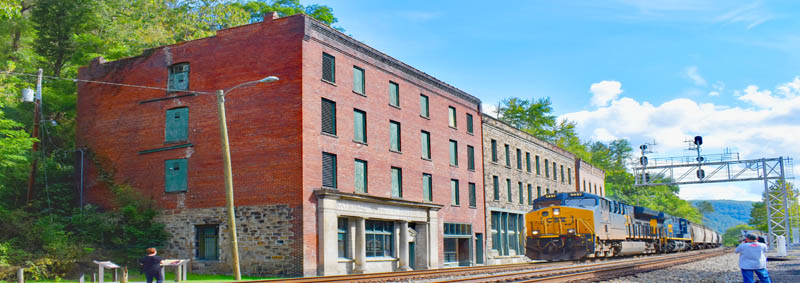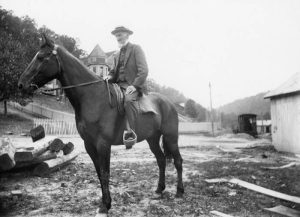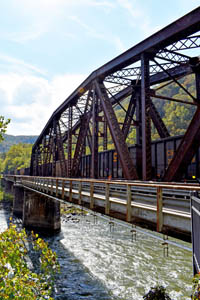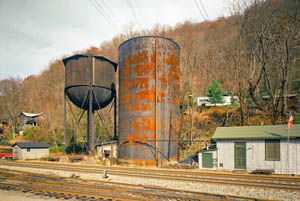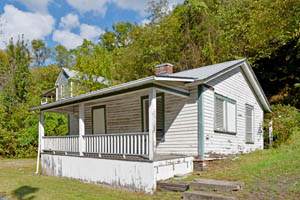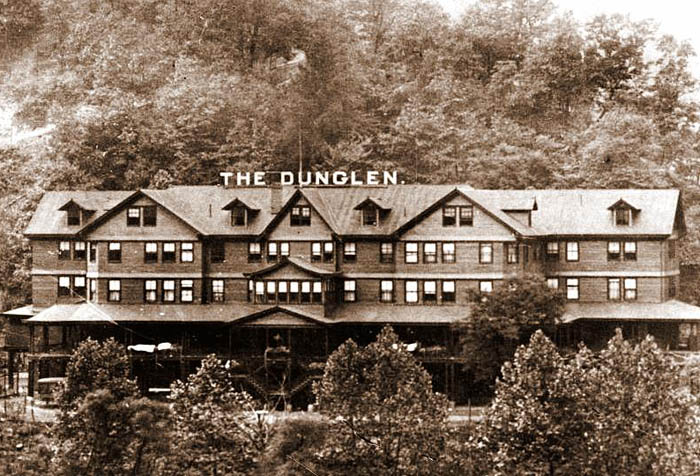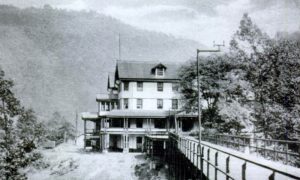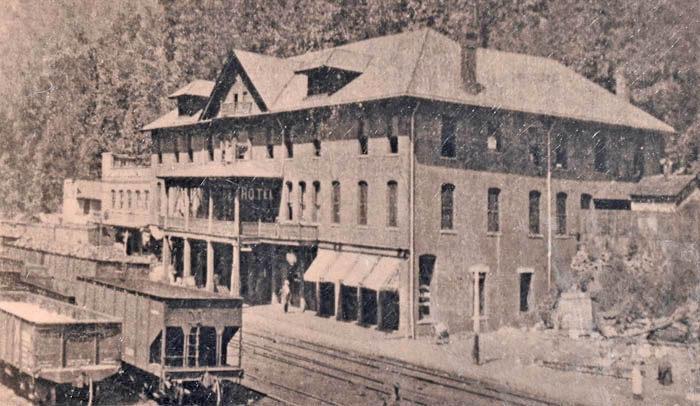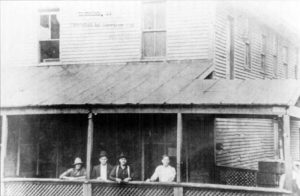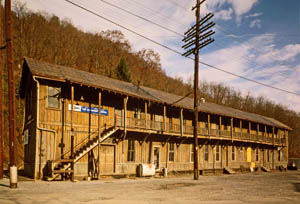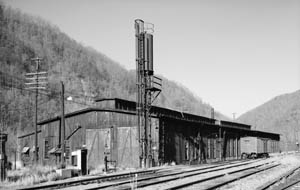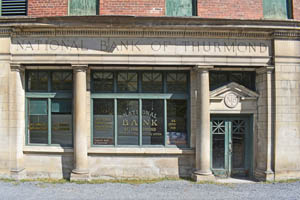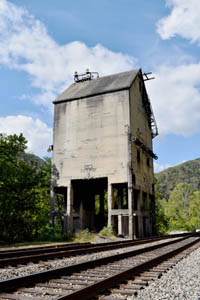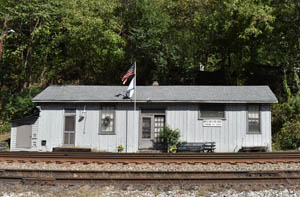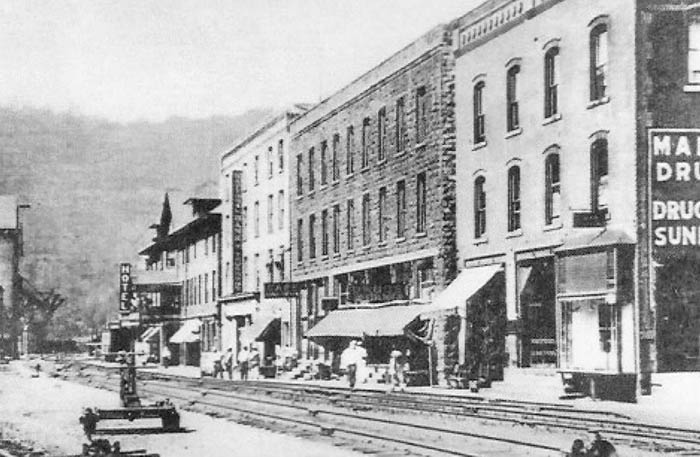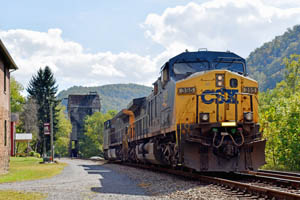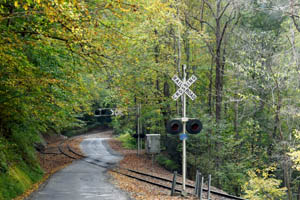Thurmond, West Virginia, is a ghost town located on the New River in Fayette County. A former railroad community, Thurmond was a prosperous town with numerous businesses.
Captain William D. Thurmond established the settlement after being commissioned to survey the land on the north side of New River in the heart of New River Gorge. As payment for his services, he received 73 acres of land in April 1873. The same year, the Chesapeake & Ohio Railroad opened its main line from the Atlantic Ocean to the Ohio River.
William Thurmond had lived in the area since 1844 and served as the leader of a band of Partisan Rangers supporting the Confederate cause in the Civil War. Afterward, he became an active businessman and banker.
In the beginning, only one house was built on the townsite in 1884. However, when the Chesapeake & Ohio Railroad bridged the New River in 1888-1889, just a couple hundred yards east of Thurmond on the south side of the river, things began to change. A two-story wood-framed railroad station was built in 1888 on land that Captain Thurmond had donated the prior year. Soon Thurmond’s land became an asset yard for the railroad. A 70-foot turntable was constructed but was quickly made obsolete and replaced with a 100-foot turntable.
A post office called Arbuckle also opened in 1888.
Soon afterward, Thomas G. McKell of nearby Glen Jean, West Virginia, who owned a lot of property around the railroad line, wrote to the President of Chesapeake & Ohio Railroad, asking for assistance in getting a branch rail line built connecting to the mainline at Thurmond. McKell wanted to open up the coal lands around Loup Creek instead of in the New River Gorge.
After negotiations, the railroad began construction on the branch line in 1892, and by late 1893 the rail line was completed from Thurmond to Glen Jean. On November 7, 1893, the first coal was shipped from the Collins Colliery Company in Glen Jean. Within no time, the Loup Creek line was one of the railroad’s busiest branches in the New River region, as it served multiple coal mines in the rich Sewell coal seam. Thurmond then became a boomtown.
Two water tanks provided the water supply for the steam that powered the railroad engines. The tanks eventually served five water columns, the engine house, and the fire hose house. An elevated tower was built in 1914 and had a 100,000-gallon capacity. A standpipe tower was erected in 1927 that could hold 210,000 gallons of water. CSX Railroad, formerly the Chesapeake & Ohio Railroad, removed the tanks in 1998. All that is left today are the foundations.
With the completion of the Thurmond Railroad Bridge, the mining industry could open new mines and ship coal more easily. Completed to Glen Jean in 1893, the C&O Loup Creek branch served 26 mines and was one of the railroads’ busiest spurs in the New River region.
The Hotel Thurmond was built next to the tracks in 1891. The simple frame construction contained 25 guest rooms and was the first lodging business to operate in Thurmond. In 1899, the Hotel Thurmond burned down.
W. D. Thurmond built about 30 one and two-story houses upon the mountainside that he rented to workers.
Captain Thurmond was a straight-laced southern gentleman and prohibited liquor in the community. On the other hand, Thomas McKell was a sharp operator and built a small village across the New River, where there were no such prohibitions. Within no time, saloons and gambling houses sprang up in his village.
In 1900, McKell built the Dunglen Hotel on the south bank of the New River. This large 4½-story wood-framed building with a wrap-around first-floor veranda housed not only 100 rooms but an ice plant, barbershop, laundry, post office, and a bar. The second story level was connected via a viaduct to the railroad bridge, taking guests across the river to the station. Opening in 1901, the opening night gala at the Dunglen featured an orchestra from Cincinnati. The hotel was an immediate success and became famous for its wealthy and rowdy guests.
Known for its lavish accommodations, the hotel was often referred to as the “Waldorf Astoria of the Mountains.” Rooms rented for $2.50 a night, which was more than miners earned in a week. Because of its spacious lobby, dining, and ballroom areas, Dunglen was known for its many parties and social events. Large dances were also held in the elegant ballroom, where the orchestra often played all night. The bars never closed, and the gambling room was lined with every game imaginable. According to Ripley’s Believe it or Not and the Guinness Book of World Records, the Dunglen housed the longest-running poker game, which lasted for 14 years.
Gambling stakes ran as high as $50,000 in seemingly nonstop poker games. The area’s largest coal mine transaction occurred in the hotel — a more than 1-million-dollar sale of one of the local mines. In a well-remembered poker game, a gambler was said to have lost his coal mine. Legends say that some of the significant money disputes led to more sinister crimes.
The hotel defined the village’s character as Dunglen became a famous resort with drinking, gambling, and numerous stories of sex and violence.
To the east of the hotel, there were worker houses and a row of Black shanties on the hill above the station. On the southside near the Dunglen developed an area called “Ballyhack” or “Bahalac” that became famous for its saloons, gambling, and prostitution. These cheaper saloons sold whiskey by the quart, and weekends would find miners and train crews spending their money on liquor and prostitutes.
In the following years, the hotel’s reputation for good times attracted local and national visitors who dubbed the attraction “Dodge City of the East.” Though the hotel continued to be popular, it also gained a reputation due to the numerous stories of murders, robberies, and crimes committed. Some said that corpses floated in the river or were eviscerated on the tracks. Some of these people were union organizers. On one occasion, a dead man was found in the river with $80, a watch, and a pistol. The corpse was fined for carrying a weapon which was paid for with the money and the watch, and he was buried in the potter’s field.
It became a great “hideout” for outlaws on the run with no roads in or out. It was so bad that one pastor said that the only difference between Hell and Thurmond is that a river runs through Thurmond.
In the meantime, Captain Thurmond continued to enforce laws within his town according to his strict Baptist beliefs. However, to his dismay, the larger community and the name “Thurmond” became synonymous with exuberant lawlessness.
In 1901 the three-story, 35-room Lafayette Hotel, pronounced “lay-flat” by locals, was built on the former site of the Hotel Thurmond. The hotel boasted seven bathrooms, steam heat, and 400 electric lights. The structure included a veranda that extended to the railroad tracks. The building also housed several businesses and shops, including the post office and the National Bank of Thurmond, owned by William D. Thurmond. The one thing that the hotel did not provide was liquor. Unfortunately, this structure, along with the Armour Meatpacking Plant, burned down in 1963. No trace of the Lafayette Hotel remains today, except for a lot that has been empty for decades.
In its early years, one lively character in Thurmond was Harrison Ash, who was said to have seven notches in his gun. Ash, originally from Virginia, migrated along with his three brothers to southern West Virginia at the turn of the century. Formerly a railroad detective and an agent for the Baldwin-Felts Detective Agency, Ash became Thurmond’s Chief of Police in about 1902. His primary duties were to keep the ruffians, gamblers, and thieves who roamed the muddy streets across the river near the Glendun Hotel from interfering with Thurmond’s respectable citizens and visitors. Standing six-foot-four and weighing more than 275 pounds, Ash seemed tailor-made for the challenge.
Using all necessary force to accomplish the job, he became part of the folklore of violence and colorful mayhem associated with the Thurmond community. Legend maintains that he frequented the drinking establishments that he patrolled, and in his off-hours, he ran his own saloon across the river in the Ballyhack.
When Thurmond was incorporated in 1903, the town was named for Captain W. D. Thurmond, and the post office name was changed to Thurmond.
The original depot burned in 1903 and was replaced a year later by the existing two-story Thurmond Depot. At one time, a freight shed extended out over the riverbank behind the station, and an engine turn-around once sat between the rear station and the railroad bridge. The ground floor of the building was used for the ticket agent’s office, baggage room, waiting rooms, restrooms, and a snack/newsroom. The second floor housed the signal tower, offices of the dispatcher, trainmaster, and conductor, and coal buyers’ offices. The depot averaged 15 passenger trains daily in the early 1900s.
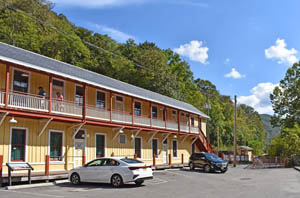
The restored depot in Thurmond, West Virginia serves as a visitor’s center today by Kathy Alexander.
Today the Thurmond Station is a landmark structure in the old town. Essentially unchanged after more than a century, the two-story frame structure now serves as a National Park Visitor Center. Much of the interior is still in place, including the round, tongue and groove ticket windows and waiting room benches.
The Mankin-Cox Building was also built in 1904 at the southern limits of the commercial district. Dr. J.W. Mankin built the three-story structure on a 150-by-40-foot lot that he had paid $4,000 for. The building had offices on the second floor for the Mankin Drug Company, while his wife, a pharmacist, operated a drug store in the right-most storefront. The second floor also hosted Dr. Young, Thurmond’s dentist. The top floor held apartments. Next door to the pharmacist, Thomas McKell opened the New River Banking & Trust Company on August 11, 1904. Just weeks later, McKell died on September 7, 1904, at the age of 59. His son William McKell took over the operations of the bank and the Dunglen Hotel. The Mankin-Cox Building is the oldest in the commercial district.
In 1905 an Armour Meatpacking Plant was established in Thurmond. The two-story building held the processing and refrigeration area on the first level and apartments for employees on the second level. The plant operated until 1932. The building burned down in 1963 along with the adjacent Lafayette Hotel.
The C&O engine house and shop were also constructed in 1905. A crew office at the eastern end was where train crews were selected to deliver empty coal cars or pick up new, loaded ones. In the beginning, the Engine House employed about 50 to 70 men. The engine house was enlarged to 245 feet in 1921 to service up to four engines at one time. At its peak, the facility employed 175 mechanists, pipefitters, boilermakers, electricians, and blacksmiths to service and maintain two engines at one time. AT this time, these men served between 60-100 railroad cars daily. From 1963, the building was used as a repair shop until it was abandoned in 1985. The building burned on August 21, 1993.
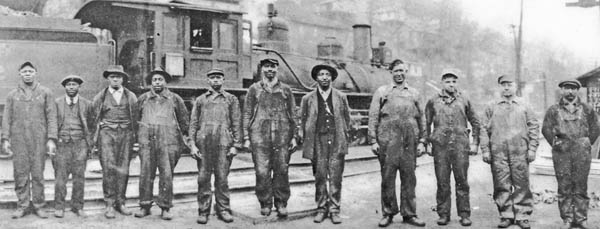
Railroad workers in Thurmond, West Virginia.
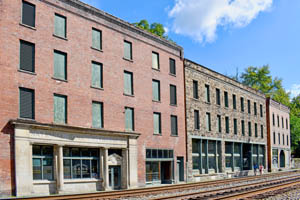
Remaining business buildings in Thurmond, West Virginia. The Goodman-Kincaid building is on the far right. Photo by Kathy Alexander Alexander.
In 1906 the three-story Goodman-Kincaid building was built by the Standard Dry Goods Company. The structure also housed the Chesapeake and Potomac Telephone Exchange Company and Dr. C.F. Ridge on the second floor. The upper floors also included apartments. The Standard Dry Goods Company added the stone facade in 1907. Standard operated out of the building until 1918. Later the main floor was called home to two stores and several restaurants. Residents lived in the building until 1959 at which the roof started to collapse.
By 1910, Thurmond produced $4.8 million of freight revenue for the C & 0, almost 20% of its revenue. It was ten times more than Richmond and 2½ times more than Cincinnati, Ohio.
Prohibition was passed in 1914, curtailing much of the “boomtown” rowdiness and effectively ending the “red light” district that was McKell’s community. It also ended the longest poker game played at the Dunglen Hotel.
In 1917 the Bullock Realty Company built a four-story structure that initially housed a jewelry store, clothing store, the Western Union Telegraph Company, and apartments. The jewelry company vacated the building in 1922. The National Bank of Thurmond, which had been housed in the Lafayette Hotel, acquired the building for $24,000 and immediately began renovations. The first level was initially created with cast-iron storefronts on the first level, but the bank remodeled their half into a limestone classical revival facade. The bank oversaw $4.8 million a year in the late 1920s, primarily from the railroad.
In 1917, a road was blazed to Thurmond, which, in the end, would be one of the reasons for its ultimate demise.
During the first two decades of the 20th century, Thurmond handled more freight than Richmond, Virginia, and Cincinnati, Ohio combined. Nearly 95,000 passengers utilized the depot yearly, and over 150 people worked for the railroad as laborers, brakemen, and dispatchers, with 18 train crews operating out of Thurmond.
In 1922, the town suffered a major fire that burned through the south side of Thurmond, destroying much of the town’s infrastructure, and many establishments moved away.
The C&O’s coaling tower and the sand house were constructed in 1922 of reinforced concrete. A New York construction firm employed 25 men to build the structure at the cost of $85,000. Coal hopper cars dropped their load into a pit underneath the building, and the coal was moved via elevator from the pit into the tower. From there, it dropped down chutes into the coal tenders of the engine atop the tracks running alongside. The C&O retained its steam locomotives more than any other major railroad operator, but the coaling tower and sand house were abandoned in 1960.
The Thurmond Union Church was constructed in 1927, replacing an earlier structure. The first floor was used for Sunday School rooms, and the second floor is the sanctuary. Over the years, it supported Baptist, Methodist, and Presbyterian congregations.
In 1929, D.D. Fitzgerald constructed the commissary under an agreement with the C&O Railroad. Fitzgerald owned the building and leased the property from the railroad. After the Lafayette Hotel was destroyed by fire in 1963, taking with it the post office, the commissary was converted into the town’s post office. It was closed in 1995.
On July 22, 1930, a devastating fire broke out at the Dunglen Hotel about 10:30 p.m. The fire was so fierce that by the time that the Mt. Hope and Oak Hill fire departments arrived, the building was entirely in flames.
Although no guests were injured, two men suffered minor burns. The fire destroyed the building, including the Earl Nichols grocery and soda counter in the terrace basement. Though faulty electrical wiring was blamed, the fire was suspicious, and there was some talk of arson. Damages totaled $100,000, more than 1.6 million in today’s dollars. Afterward, the property was abandoned. The burning of the Dunglen brought a swift demise to one of the wildest places in West Virginia history.
By this time, there were other indications that Thurmond’s heyday was ending as the American public had begun its love affair with the automobile. Good roads made travel by car easy and reduced passenger travel on the railroad.
The National Bank of Thurmond closed in 1931 after a series of fires devastated the town. After many businesses closed due to the fires, the bank was forced to close as well. Afterward, the New River Banking and Trust Company relocated to the building until it moved again to Oak Hill in 1935. Afterward, a clothing store and other retail stores operated out of the building, and residents lived there until 1959. In 1975, the building owners connected it to an adjoining building and formed The Bankers Club, a hotel and restaurant that was popular for years. However, it too closed in 1988, and the building has since been unoccupied.
By this time, businesses were waning as the Great Depression overtook the country. In addition to the Thurmond National Bank closing in 1931, the Armor Meat Company closed its doors in 1932. The New River Bank, owned by the McKell family, moved to Oak Hill in 1935, and the C&P telephone district offices closed in 1938.
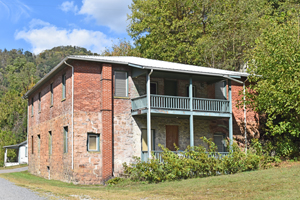
The Childers-Richmond House in Thurmond, West Virginia was built as the Power Building in 1900. Later it was used as a residence by two separate owners.
For 35 years, Thurmond was inaccessible except by railroad. Though the town had not a single street in its prime, it had two banks, two hotels, a movie theater, boarding houses, restaurants, a jewelry store, clothing stores, general stores, and a population of about 500 at its peak.
In 1930, Thurmond was called home to 462 people, but by 1940 it had dropped to 339. In the following years, the population would continue to fall.
The last major industry left in Thurmond was the railroad, and even it ceased to be a factor in 1949 when the Chesapeake and Ohio Railway changed from steam to diesel locomotives, and there was no longer a need to stop at Thurmond for water and coal. This left many of the rail yard structures and jobs obsolete. Soon afterward, the Thurmond depot closed.
Thurmond saw a small revival during World War II when coal was in high demand, but it was not enough. Afterward, the coalfields began to play out.
In 1978, the National Park Service established the New River Gorge National Park, and a management plan identified Thurmond as a prime historical site in 1982. In 1984 the Thurmond Historic District was listed on the National Register of Historic Places.
By this time, many of the residents and houses were gone. In 1980, Thurmond’s population had dropped to 67.
In 1985, the Chessie System, the successor to the Chesapeake & Ohio Railway, agreed to sell the derelict depot to the National Park Service. Property acquisitions increased in 1989 when much of the town property was acquired. After three years of negotiations, the Thurmond depot was purchased from CSX Transportation, the successor to Chessie, in July 1991 for $50,000.
In 1992, the National Park Service developed a $35 million plan to establish Thurmond as a tourist site. The depot required extensive work, including foundation work, construction, retaining walls, and a sewage plant at the cost of $2.5 million. Nearly $1.3 million was allocated for the stabilization of the commercial buildings in the center of Thurmond. Unfortunately, the engine house was destroyed by a suspicious fire in August 1993.
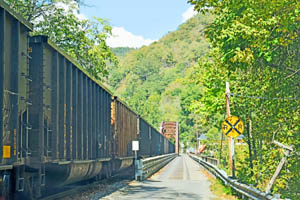
The Access Road into Thurmond, West Virginia is a one-lane road right next to the railroad tracks by Kathy Alexander.
The post office closed in 1995. The same year, the depot was fully rehabilitated and began to be used as a visitor’s center and an Amtrak station.
In 1999, the water towers were razed over concern of its potential collapse.
Today, Thurmond has just about four residents. As the remaining people either move on or pass away, their homes and the land it sits on becomes the property of the National Park Service. Contributing structures to the historic district are restored while other intrusive buildings are removed.
Most Thurmond property is owned by the National Park today. The entire town is a designated historic district on the National Register of Historic Places. Thurmond is the least-populous municipality in West Virginia.
To reach Thurmond, take U.S. Route 19 to the Glen Jean exit, north of Beckley. Follow the signs to Thurmond, seven miles down WV Route 25. This road is narrow and winding and is not recommended for RVs and trailers.
©Kathy Weiser-Alexander/Legends of America, October 2021.
Also See:
West Virginia – The Mountain State
Travel Blog – Finding Our Lumps in West Virginia
Sources:
Abandoned
Clio
National Park Service
National Register Nomination
New River Gorge Convention and Visitors Bureau
West Virginia Encyclopedia
Thurmond, West Virginia
Wikipedia

